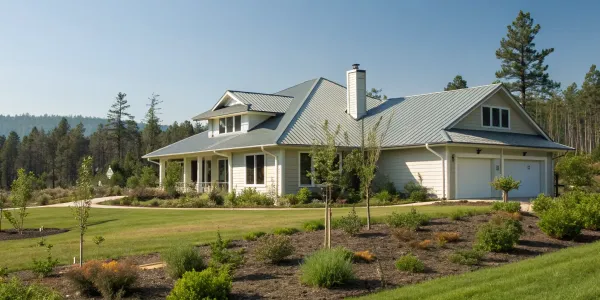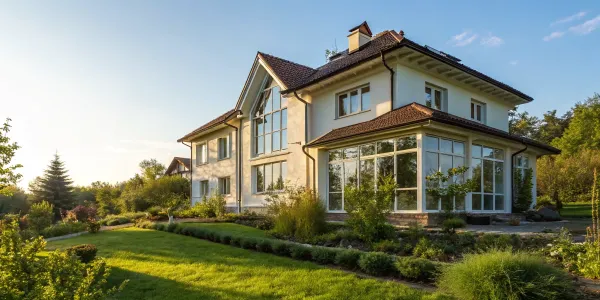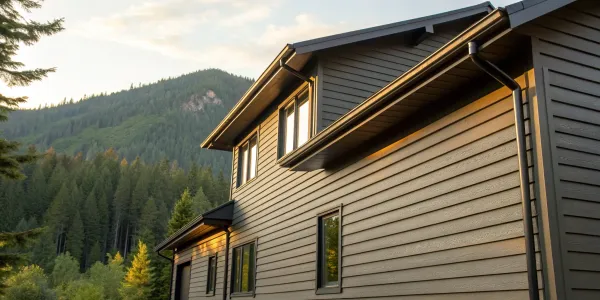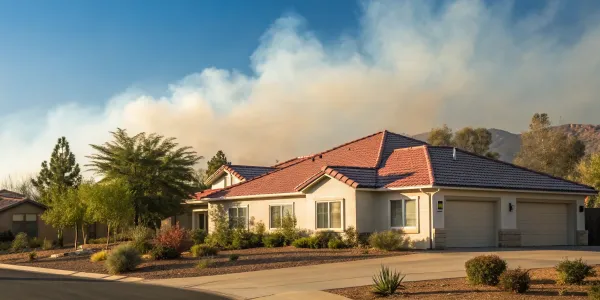Are Fiberglass Windows Fire Resistant? A Homeowner's Guide
Curious about fire safety? Find out are fiberglass windows fire resistant, how they compare to other materials, and what features matter for your home.
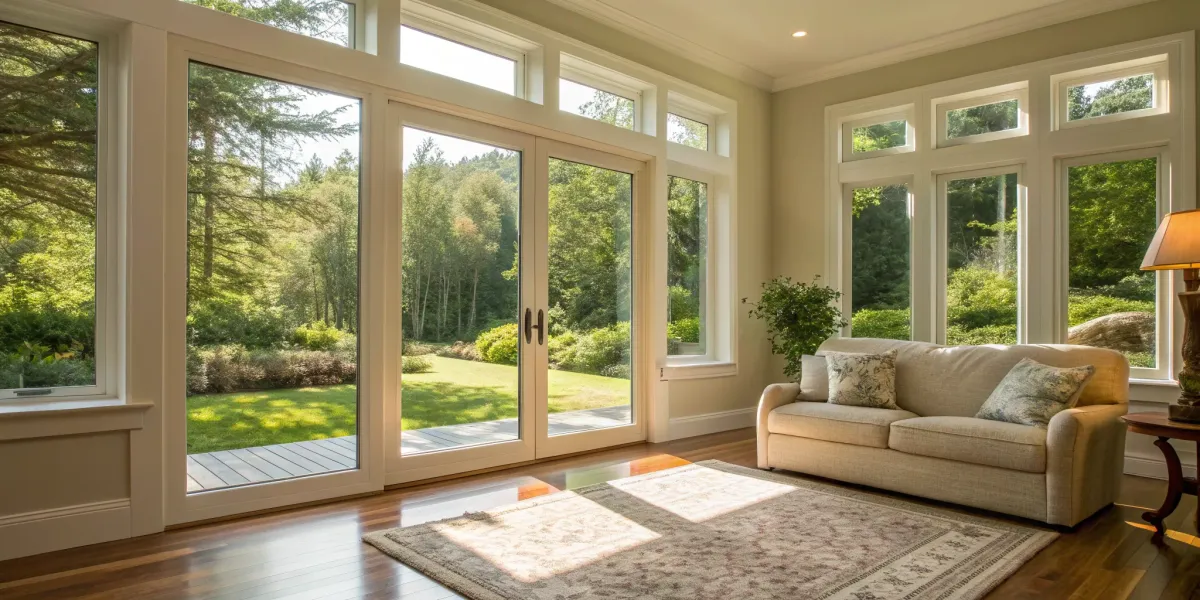
Building a home that meets modern safety standards is about more than just following the rules; it’s about creating a resilient structure that’s both safe and insurable. In wildfire-prone areas, building codes and insurance requirements are stricter than ever, placing a heavy focus on the materials used for your home’s exterior. Windows are a major point of inspection. Before you commit to a plan, you need to know: are fiberglass windows fire resistant and do they satisfy these stringent guidelines? We’ll explore how choosing the right windows can help you meet code, improve your home’s insurability, and provide lasting peace of mind.
WiserBuild CTA Button
Key Takeaways
- Prioritize Fiberglass Frames for Fire Safety: Fiberglass stands up to extreme heat without melting like vinyl or burning like wood, ensuring your window frames maintain their structural integrity when it matters most.
- Look Beyond the Frame for Full Protection: A fire-resistant window is a system. Combine a strong fiberglass frame with dual-pane tempered glass and professional installation to create a reliable barrier against heat and embers.
- Verify Compliance and Add External Defenses: Ensure your windows meet local fire codes and consider adding metal screens or fire-rated shutters to block embers—the leading cause of home ignition during a wildfire.
What Are Fiberglass Windows?
When you’re choosing materials for your home, especially in an area prone to wildfires, every detail matters. You’ve likely heard about fiberglass windows, but what makes them such a smart choice? Simply put, they are made from a composite of thin glass strands and a durable resin, woven together to create an incredibly strong frame. They are about eight times stronger than vinyl, which means they are built to last and can withstand some of the toughest conditions. This strength is a game-changer when it comes to protecting your home.
How Fiberglass Is Different
The biggest difference, especially when thinking about fire safety, is how fiberglass performs under pressure. Unlike vinyl, which can melt or warp when exposed to high heat, fiberglass window frames are designed to resist fire. They don’t easily bend or lose their shape and can handle much higher temperatures before showing any signs of damage. This resilience is exactly what you need when every second counts. For homeowners in high-risk areas, choosing materials that improve protection against wildfires isn't just a good idea—it's a critical part of a solid safety plan.
A Look at Their Construction
The secret to their strength lies in how they’re made. Fiberglass windows are built from a composite material that combines glass fibers with a strong resin. This process creates a durable and stable frame that holds its shape, even with extreme temperature swings. Think about the intense heat of a summer day followed by a cool night—fiberglass won’t warp or crack the way other materials might. This stability ensures your windows maintain a tight seal, which is crucial for keeping out not just the elements, but also smoke and embers during a fire.
More Than Just Fire Resistance
While their fire resistance is a huge plus, the benefits of fiberglass windows don’t stop there. They also provide excellent insulation, which can help lower your energy bills and keep your home comfortable. Many homeowners also love their appearance; they can be designed to look like real wood without the high maintenance. Plus, they’re a more environmentally friendly option, as the frames are often made from recycled glass. When you compare fiberglass to vinyl, you're getting a material that’s strong, safe, and efficient—a combination that’s hard to beat.
How Fiberglass Windows Stand Up to Fire
When you’re thinking about protecting your home from a wildfire, windows are one of the most vulnerable points. It’s not just about the glass breaking; the frame material plays a massive role in whether your window holds up or fails under pressure. This is where fiberglass really shines. Unlike other common materials that can melt, warp, or even burn, fiberglass is engineered to withstand extreme conditions, making it a smart choice for homes in high-risk areas.
The secret is in its composition. Fiberglass is made from fine strands of glass woven together and set in a resin. This creates a thermoset material, which means that once it's cured, it won't melt or lose its shape when exposed to high heat. This stability is crucial during a fire. A window that maintains its structural integrity can be the difference between a close call and a catastrophe, keeping flames, embers, and smoke on the outside, where they belong. Choosing fiberglass is a proactive step toward building a more resilient home that can better defend itself against the threat of fire.
Resisting Extreme Heat
During a wildfire, your home is bombarded with intense radiant heat long before the flames ever get close. This heat alone can cause some window frames to fail. Vinyl frames, for example, can soften, warp, and melt under high temperatures, compromising the entire window unit.
Fiberglass, on the other hand, is built to take the heat. Because it’s a thermoset material, it doesn't melt or bend easily and can handle higher heat without catching fire. This means that as the temperature outside rises, your fiberglass window frames will hold their shape and maintain their seal, providing a much more reliable barrier against the fire’s approach. This resilience gives your home a critical advantage when every second counts.
Staying Strong in a Fire
A window’s main job during a fire is to stay in one piece. A window fails when the glass shatters or when the frame gives way, creating an opening for fire to enter. Fiberglass frames are exceptionally good at maintaining their integrity under the extreme stress of a fire. While vinyl can melt away and wood can burn, fiberglass remains stable and strong.
This structural stability is what keeps the glass securely in place and the window unit sealed. By preventing the frame from collapsing, fiberglass reduces the risk of a breach that could allow embers and flames inside. This ability to stay intact under pressure makes fiberglass a key component in creating a strong, defensive shell for your home, helping to keep the interior safe from the fire outside.
Why They Won't Catch Fire
One of the most important qualities of a fire-resistant material is that it doesn’t contribute fuel to the fire. Wood frames are naturally combustible, and while vinyl isn’t as flammable, it can melt and deform when exposed to heat. Fiberglass, however, is in a different league. It’s an inert material that resists ignition at much higher temperatures than other common frame materials.
This means that even when faced with direct flames or intense radiant heat, a fiberglass frame won't catch fire. It won’t burn, and it won’t release flammable gases. This non-combustible nature is a fundamental safety feature, as it ensures your windows won’t become another source of fuel that helps the fire spread to the rest of your home.
Blocking Smoke and Embers
In most wildfires, the biggest threat to homes isn't the main wall of fire, but the storm of tiny, wind-blown embers that can travel for miles. These embers can get into your home through the smallest gaps and ignite it from the inside. This is why a window’s seal is so important. If a window frame warps from heat, it can create openings for embers and smoke to sneak through.
Because fiberglass frames don't warp or melt, they maintain a tight, secure seal around the glass. This prevents those dangerous embers from finding a way in. Having reliable, fire-resistant windows that keep a tight seal is one of the most effective ways to harden your home against wildfire, ensuring that your windows serve as a solid barrier, not an entry point.
Fiberglass vs. Other Window Materials
Choosing the right window material is one of the most critical decisions you'll make when building or renovating in a high-risk area. Windows are often the most vulnerable part of a home's exterior during a wildfire, so the material you select can make all the difference. While options like vinyl, wood, and aluminum are common, they each have significant drawbacks when exposed to extreme heat. Let's break down how these materials compare to fiberglass so you can make an informed choice for your home's safety.
How Vinyl Windows React to Fire
Vinyl windows are popular because they're affordable and low-maintenance, but they are not a safe choice for homes in wildfire-prone regions. The primary issue is their low melting point. When exposed to the intense heat of a wildfire, vinyl frames can warp, melt, or even ignite very quickly. This failure compromises the entire window assembly, allowing embers and flames to enter your home. A window can fail either when the glass breaks or when the frame gives way, and with vinyl, the frame is a significant weak point. This is why many building guides for wildfire resilience specifically advise against using vinyl window frames.
The Problem with Wood Windows
Wood frames can offer better fire resistance than vinyl, but they are still a combustible material. While thicker, high-quality wood can take longer to ignite, it will eventually burn when exposed to sustained flames or extreme radiant heat. Once the frame catches fire, it compromises the structural integrity of the window, creating an entry point for the wildfire. Wood also requires regular maintenance, like painting or sealing, to protect it from the elements. If this maintenance is neglected, the wood can become dry and even more susceptible to ignition, making it a risky choice where fire safety is the top priority.
What to Know About Aluminum Windows
Aluminum frames are a step up from vinyl and wood because they don't burn. However, they present a different kind of problem: heat conduction. Aluminum is an excellent conductor of heat, which means that in a fire, the frame can get incredibly hot. This intense heat can transfer to the glass, causing it to expand and shatter, even if the frame itself remains intact. Once the glass breaks, your home is left vulnerable to embers and flames. While aluminum is a durable material in many respects, its thermal conductivity makes it less than ideal for protecting your home against the extreme temperatures of a wildfire.
Why Fiberglass Is the Clear Winner
When it comes to fire resistance, fiberglass stands out as the superior material. Made from glass fibers and resin, fiberglass frames have a very high melting point and do not ignite, melt, or warp when exposed to high heat. They maintain their structural integrity far longer than other materials, keeping the glass securely in place. This stability is why organizations like FireSmart Canada recommend fiberglass for homes in high-risk areas. Unlike aluminum, fiberglass is an insulator, not a conductor, so it doesn't transfer heat to the glass. This combination of strength and low thermal conductivity makes fiberglass the most resilient and reliable choice for protecting your home.
Must-Have Features for Maximum Protection
A fire-resistant frame is a fantastic start, but the glass and other components are just as important for creating a truly resilient window. Think of it as a system where every part has a job to do. To get the most out of your fiberglass windows, you’ll want to make sure they include a few key features that work together to keep your home safe.
The Role of Dual-Pane Glass
You’ve probably heard of dual-pane windows for their energy efficiency, but that extra layer of glass also adds a layer of fire protection. These windows have two sheets of glass separated by a layer of air or gas, which acts as an insulator against heat. This design can buy you precious time in a fire. However, it’s important to have realistic expectations. During intense heat or direct flames, the glass can still break after just one to three minutes. That’s why dual-pane glass is a great starting point, but it works best when combined with other fire-resistant features.
Why Tempered Glass Matters
For a significant step up in durability, look for tempered glass. This type of safety glass is treated with high heat and then rapidly cooled, a process that makes it about four times stronger than standard glass. When faced with the extreme heat of a fire, that extra strength makes it far less likely to shatter. If it does break, it crumbles into small, pebble-like pieces instead of dangerous shards. This strength against thermal shock is exactly what you need in a high-risk area. Many building codes in wildfire-prone regions now require tempered glass in exterior windows for this very reason.
Secure Seals and Frames
A window is only as strong as its weakest link. A window can fail if the glass breaks or if the frame itself gives way. This is a major problem with vinyl frames, which can melt, warp, or even catch fire, causing the glass to fall out and expose your home. High-quality fiberglass frames solve this problem because they don’t burn or melt. They maintain their structural integrity even in extreme heat, keeping the glass securely in place. When paired with durable, heat-resistant seals, fiberglass window frames ensure the entire window assembly works together to resist fire.
Adding Screens and Shutters
To give your windows an extra layer of defense, consider installing metal screens. A fine mesh screen can do wonders to block wind-blown embers—the number one cause of home ignition in a wildfire. Look for screens with a mesh size of at least 1/16-inch, as this is small enough to stop most embers from passing through. While screens won't stop direct flames, they can prevent embers from piling up against the glass and causing it to break. For even greater protection, you can install fire-rated shutters that close over the windows, providing a solid barrier against both radiant heat and flames.
Meeting Building Codes and Safety Standards
Choosing the right windows isn't just about aesthetics or energy efficiency—it's about safety and compliance. Building codes exist to protect you, your family, and your community, especially in areas where wildfires are a known risk. Following these standards ensures your home is built to a higher level of safety and can even make it easier to insure. Think of these codes not as restrictions, but as a roadmap for building a stronger, more resilient home. When you understand the requirements for your area, you can make informed decisions that provide peace of mind before construction even begins.
Understanding Fire Code Requirements
If you live in a region prone to wildfires, you’ve probably heard of the Wildland-Urban Interface, or WUI. This is the zone where homes and wildlands meet, and it's where the risk of fire is highest. In response, places like California and British Columbia have updated their building rules to demand better wildfire protection for homes in these areas. These codes often specify the types of materials you can use for everything from roofing to windows. Getting familiar with your local fire code requirements is a critical first step in any new build or renovation project.
Guidelines for Wildfire-Prone Areas
When it comes to windows, safety organizations have clear recommendations. Experts at FireSmart and Natural Resources Canada suggest using fiberglass for window frames in high-risk areas because of its durability and heat resistance. This guidance is echoed in building codes across North America. For example, California’s building standards emphasize that fire-resistant windows are one of the most important features for new homes built in high-risk zones. Following these expert guidelines helps ensure your home has a strong defense against embers and extreme heat, which are the primary threats during a wildfire.
Look for Official Certifications
How can you be sure a window will perform as advertised? Look for official certifications. Some window materials, like certain types of vinyl, can melt or warp in high heat, causing the glass to fall out and leave your home exposed. To avoid this, look for windows that meet the AAMA/WDMA/CSA 101/I.S.2/A440 Standard, which often include metal reinforcements for added strength. Additionally, any genuine fire-rated glass will have permanent markings and certifications etched directly onto it. These labels are your proof that the product has been tested and meets strict safety standards.
A Checklist for Homes in High-Risk Areas
When you live in an area prone to wildfires, every choice you make about your home’s exterior matters. Windows are a critical part of your defense, acting as a barrier between your family and the elements. But with so many options and requirements, it’s easy to feel overwhelmed. This checklist breaks down the most important considerations for your windows, giving you a clear path forward.
Think of this as your guide to making smart, resilient choices. From the materials you select to the person you hire for installation, each step plays a role in your home’s overall safety. A little planning now can make a significant difference in how your home stands up to risk, giving you peace of mind before, during, and after a fire event. By focusing on these key areas, you can feel confident that your windows are contributing to a safer, more insurable home.
Key Safety Features to Prioritize
When it comes to fire resistance, the window frame material is your first line of defense. As experts at Cascadia Windows & Doors note, "Fiberglass window frames are much better at resisting fire than traditional materials like vinyl." That’s because fiberglass can handle high heat without melting, warping, or catching fire, which keeps the glass secure when it matters most. Beyond the frame, look for windows with dual-pane tempered glass. This combination provides an extra layer of insulation against extreme heat and is much stronger than standard single-pane glass, making it less likely to shatter and expose your home to embers.
Why Professional Installation Is Crucial
You can choose the best fire-resistant window on the market, but it won’t perform as expected if it’s not installed correctly. A window is a complete system, and as the team at Bridgewater Glass explains, "The entire system, including the glass, its frame, seals, and other parts, must be fire-rated and installed correctly by someone who knows what they're doing." A professional installer ensures there are no gaps around the frame where heat and embers could penetrate. They use the right sealants and techniques to create an airtight fit, which is essential for maintaining the window’s integrity during a fire. Don’t cut corners here—proper installation is just as important as the window itself.
Think About Window Placement
Strategically placing your windows can also reduce your home’s vulnerability. During a wildfire, "windows are often the weakest part of a building," because the glass can break from intense heat or the frames can melt and ignite. When designing or renovating your home, consider the landscape around you. If possible, limit the number of large windows on sides of the house that face dense vegetation or steep, fire-prone slopes. This doesn’t mean you have to sacrifice natural light, but being thoughtful about placement can reduce the direct exposure of your home’s most vulnerable points to radiant heat and flying embers.
Go the Extra Mile with Protection
For an added layer of security, consider external protection for your windows. According to Fire Safe Marin, you should "install metal window screens." These screens do more than just keep bugs out; they can help deflect embers and reduce the amount of radiant heat that reaches the glass, giving your windows a better chance of survival. Non-combustible, fire-rated shutters are another excellent option. They can be closed during a wildfire threat to provide a strong, solid barrier over the glass. These extra measures can significantly strengthen your home’s defenses in a high-risk area.
How to Maintain Your Fire-Resistant Windows
You’ve made a smart investment in fire-resistant windows, but their job isn’t over once they're installed. Just like any other critical part of your home, they need a little attention to stay in top shape and perform as expected if you ever need them to. Regular maintenance is key to protecting your home and your family, ensuring the window's fire-resistant properties aren't compromised over time by wear and tear. A few simple checks and cleaning routines can make all the difference in preserving their integrity and effectiveness.
Think of it as peace-of-mind maintenance—a straightforward way to keep your first line of defense against fire strong and secure for years to come. By creating a simple plan, you can easily stay on top of their condition and address small issues before they become major concerns. This proactive approach not only extends the life of your windows but also upholds the safety standards you chose them for in the first place.
Create an Inspection Routine
Getting into the habit of checking your windows a couple of times a year is one of the best things you can do. You don’t need to be an expert—just look for anything that seems out of place. Check the glass for any cracks or chips. Inspect the frame for warping or damage, and make sure the seals around the glass are intact and not pulling away. It's also a good idea to open and close each window to ensure it operates smoothly and latches securely. Catching small issues early can prevent them from becoming bigger problems that compromise your home's safety and fire protection standards.
Simple Steps for Long-Term Care
Keeping your fire-resistant windows clean is about more than just looks; it helps maintain their condition. A soft, wet cloth is usually all you need to wipe down the glass and frames. If you need a little more cleaning power, a mild soap or cleanser will do the trick—just be sure to avoid harsh, abrasive chemicals that could damage the materials. While you’re cleaning, pay attention to the hardware. If a window is tough to open or close, the hinges and locks might need lubrication. A quick spray of a silicone-based lubricant once or twice a year will keep everything moving smoothly.
Know When to Repair or Replace
Sometimes, a window may have damage that goes beyond a simple fix. While minor scuffs on the frame might be cosmetic, significant issues like a cracked pane, a warped frame that prevents a tight seal, or deteriorating seals are serious red flags. These problems can compromise the window's ability to block heat and embers. If you spot this kind of damage, it’s time to call a professional. They can assess whether a repair is possible or if a full replacement is necessary to ensure your window continues to meet fire safety compliance and keep your home protected.
Related Articles
- WiserBuild - Wildfire Resilient Homes & Building Code Compliance
- WiserBuild - Wildfire Resilient Homes & Building Code Compliance
- WiserBuild - Wildfire Resilient Homes & Building Code Compliance
- WiserBuild - Wildfire Resilient Homes & Building Code Compliance
WiserBuild CTA Button
Frequently Asked Questions
Are fiberglass windows completely fireproof? No window is truly fireproof, but fiberglass windows are highly fire-resistant. This means they are designed to withstand extreme heat without melting, warping, or catching fire. Their main job is to maintain their structural integrity for as long as possible during a fire, keeping the glass in place and preventing embers and flames from entering your home. Think of them as a critical tool that buys you precious time and keeps your home’s defensive barrier intact.
What's more important for fire safety, the window frame or the glass? They are equally important because they have to work together as a system. You can have the strongest tempered glass, but if it’s in a vinyl frame that melts away in high heat, the glass will simply fall out, leaving your home exposed. A strong fiberglass frame ensures the glass stays securely in place. For the best protection, you need both a heat-resistant frame and durable, dual-pane tempered glass.
Are fiberglass windows a lot more expensive than other options? Fiberglass windows do have a higher upfront cost than basic vinyl windows, but they are often priced similarly to high-end wood windows. It’s helpful to think of it as an investment in your home’s safety and durability. Because they are so strong and long-lasting, they provide excellent long-term value. Plus, choosing certified, fire-resistant materials can sometimes make your home more attractive to insurers, which is another important consideration.
Can I just replace the glass in my old window frames to make them safer? While upgrading to tempered glass is a good thought, it won’t be effective if your existing frames aren't up to the task. The frame is often the first point of failure, especially if it's made of vinyl or wood. A fire-resistant window is a complete, engineered system where the frame, glass, and seals are all designed to work together. Putting new glass in an old, weak frame won't give you the protection you need.
Besides the windows, what’s the best way to stop embers from getting inside? Since wind-blown embers are the primary cause of home ignition during a wildfire, adding another layer of defense is always a smart move. Installing fine metal mesh screens over your windows is one of the most effective things you can do. A screen with a 1/16-inch mesh is small enough to block most embers from accumulating against the glass. For even more protection, you can install non-combustible shutters that can be closed during a fire threat.

